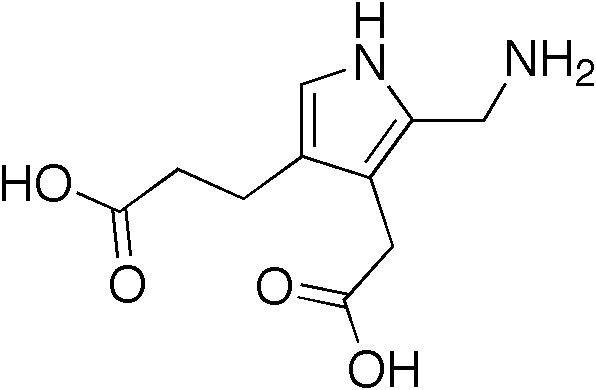Specialty endocrinology ICD-9-CM 277.1 DiseasesDB 171 | ICD-10 E80.2 OMIM 176000 eMedicine med/1880 | |
 | ||
Acute intermittent porphyria (AIP) is a genetic metabolic disorder affecting the production of heme, the oxygen-binding prosthetic group of hemoglobin. It is characterized by a deficiency of the enzyme porphobilinogen deaminase. Its inheritance is more commonly autosomal dominant, however autosomal recessive forms of this disorder have occurred. Its incidence is estimated to be between 5 and 10 in 100,000.
Contents
Signs and Symptoms
Signs and symptoms of AIP can be variable. Severe and poorly localized abdominal pain is a very common symptom (found in 95% of those affected by AIP). Urinary signs and symptoms such as painful urination, urinary retention, urinary incontinence, or dark urine have also been known to occur. Psychiatric signs and symptoms of AIP may manifest as anxiety, paranoia, irritability, aggression, obsessions, delusions, hallucinations, confusion, depression, and suicidal thoughts. Signs that suggest increased activity of the sympathetic nervous system may be evident including tachycardia, hypertension, palpitations, orthostatic hypotension, sweating, restlessness, and tremor. Other neurologic signs and symptoms of AIP include seizures, peripheral neuropathy, abnormal sensations, pain in your chest, legs, back or head, and coma. Nausea, vomiting, constipation, and diarrhea can also occur. Proximal muscle weakness typically beginning in the arms is characteristic; there can be muscle pain, tingling, numbness, weakness or paralysis; muscle weakness seen in AIP can progress to include the muscles of breathing causing respiratory failure and can be fatal.
AIP patients have an increased risk of developing hepatocellular carcinoma, melanoma, lymphoma, chronic hypertension, chronic kidney disease, and chronic pain.
Pathophysiology
AIP is caused by mutations in the HMBS gene, which codes for the enzyme porphobilinogen deaminase.
A Swedish study indicated that approximately 90% of cases of acute intermittent porphyria are due to a mutation in the HMBS gene that causes decreased amounts of the enzyme, and to a lesser degree by a mutation that causes decreased activity of each enzyme molecule.Under normal circumstances, heme synthesis begins in the mitochondrion, proceeds into the cytoplasm, and finishes back in the mitochondrion. However, without porphobilinogen deaminase, a necessary cytoplasmic enzyme, heme synthesis cannot finish, and the metabolite porphobilinogen accumulates in the cytoplasm.
Both endogenous and exogenous factors can cause acute attacks, such as certain medications, alcohol, infections, low caloric intake, or changes in sex hormone balance during the menstrual cycle or pregnancy.
Patients with AIP are commonly misdiagnosed with psychiatric diseases. Subsequent treatment with anti-psychotics increases the accumulation of porphobilinogen, thus aggravating the disease enough that it may prove fatal.Gene mutation located on chromosome 11q23.3. Mutations include deletions, inversions, and translations.
Diagnosis
Urine and serum show raised levels of porphobilinogen.
Assay the red blood cells for the level of porphobilinogen deaminase.
Treatment
If drugs have caused the attack, discontinuing the offending substances is essential.A high-carbohydrate (10% glucose) infusion is recommended, which may aid in recovery.
Hematin and heme arginate is the treatment of choice during an acute attack. Heme is not a curative treatment, but can shorten attacks and reduce the intensity of an attack. Side-effects are rare but can be serious.Pain is extremely severe and almost always requires the use of opiates to reduce it to tolerable levels. Pain should be treated as early as medically possible due to its severity.
Nausea can be severe; it may respond to phenothiazine drugs but is sometimes intractable. Hot water baths or showers may lessen nausea temporarily, but can present a risk of burns or falls.
Seizures often accompany this disease. Most seizure medications exacerbate this condition. Treatment can be problematic: Barbiturates and Primidone must be avoided as they commonly precipitate symptoms. Some benzodiazepines are safe, and, when used in conjunction with newer anti-seizure medications such as gabapentin, offer a possible regimen for seizure control.
Famous sufferers
One of the many hypothesized diagnoses of the artist Vincent van Gogh is that he and his siblings, in particular his brother Theo, suffered from AIP and syphilis. Another theorized sufferer was King George III of the United Kingdom who even had a medallion struck to commemorate his "curing". His great-great-great-great-grandson Prince William of Gloucester was reliably diagnosed with variegate porphyria in 1968. It's probable that the philosopher Jean-Jacques Rousseau suffered from porphyria.
